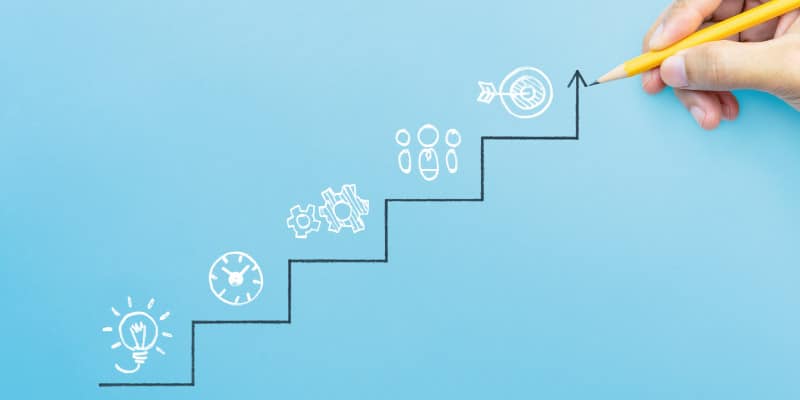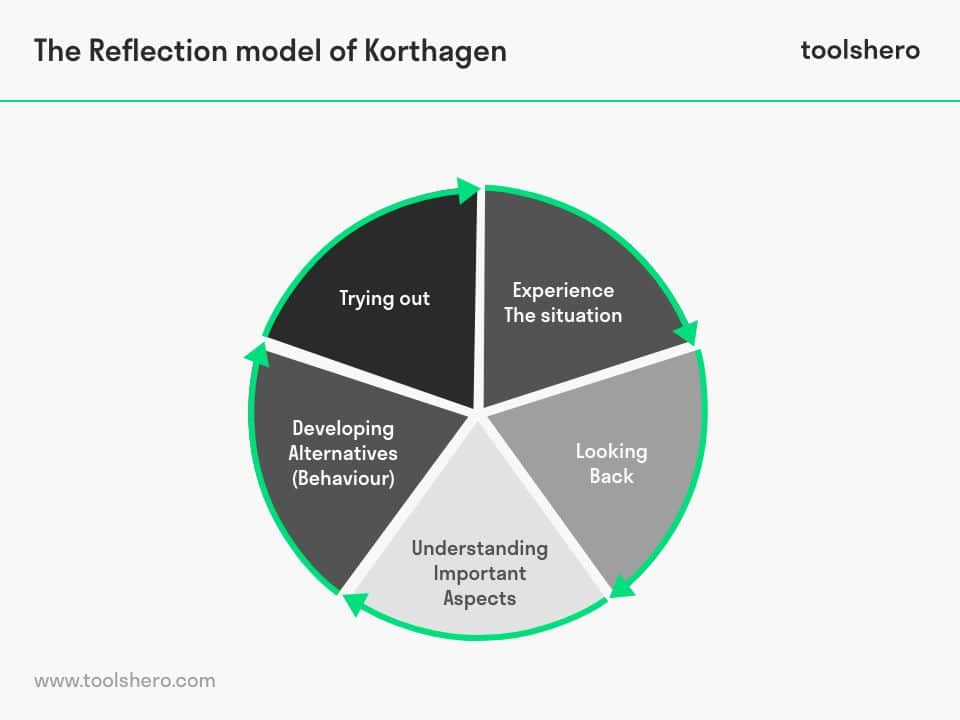Korthagen Reflection Model explained

Korthagen Reflection Model: in this article the Korthagen Reflection Model, developed by Fred Korthagen is explained in a practical way. After reading you will understand the basics of this personal development and self-reflection tool. This article contains the steps involved in process, and an example. Enjoy reading!
What is the Korthagen Reflection Model?
The Korthagen Reflection Model or Korthagen Reflection Cycle is a cyclical reflection method that is widely used among students in reports in which they reflect on their own actions. By going through this cycle one learns to reflect in a systematic way. This is important because reflection is an essential skill that must be learned in order to make the most out of yourself.
Reflection refers to the human capacity to look back in a structured way and to think about one’s actions. Korthagen’s reflection cycle is not only used by students, but also by teachers. This gives them new insights with regard to their educational performance.
Who developed the Korthagen reflection model?
Korthagen’s ideal-typical reflection model was developed by the Dutch educationalist Prof. dr. Fred Korthagen in 1993. He based the model on the learning cycle of David Kolb.
The model is currently used in many educational courses in the Netherlands. The model is also becoming known abroad, often under the name ‘ALACT model’. In the Netherlands, the model is also known as Korthagen’s Spiral Model.

Figure 1 – The 5 Stages of Reflection by Korthagen
In 2009, Fred Korthagen, together with Ellen Nuijten, published the book The Power of Reflection.
The Five Stages of Reflection
Korthagen’s model consists of the following five steps or phases:
- Experiencing a situation
- Looking back on the experience
- Understanding key aspects of the experience
- Thinking about alternative behavior for the future
- Trying out these alternatives
The phases are briefly explained below.
Phase 1 of the Korthagen Reflection Model: experiencing the situation
In the first phase, you describe the experience you had and the overall situation. You can do this using the STARR reflection method. STARR stands for: Situation, Task, Action, Result and Reflection.
To help you, you can answer the following questions:
- What was the situation concretely?
- What did I do in this situation?
- What actions did I take in the situation?
- What was the result of my actions?
Phase 2: looking back
In phase 2 you think much more carefully about the first question of the previous phase: what exactly happened?
- What happened?
- What did I see?
- What did I want?
- What was I thinking?
- What did I feel?
- What did I do?
Phase 3 of the Korthagen Reflection Model: understanding the experience
During this phase one tries to gain insight into the ‘why’ of the experience. As established in phase two, the experience includes feeling, thinking, seeing and doing. In phase 3, identifying patterns is central.
Think about the following questions:
- What does the experience mean to me?
- Why does it mean that to me?
- What’s the problem? Or what is the positive?
- What caused my experience?
Phase 4: developing alternatives
In phase four, solutions are devised for the findings from the previous phases. Do not look for 1 solution or alternative, but several. The first option may not be the best. Answer the following questions:
- What are the consequences of the findings from phase 3?
- How could I have done it differently?
- What alternatives are there for this?
- Which alternatives can I still develop?
- Which alternatives can I ultimately choose from?
Phase 5: trying out alternatives
The final phase involves trying out alternatives and turning the options into concrete actions. Think about the following questions:
- What do I want to achieve with this?
- What should I pay attention to?
- What should I avoid?
- What do I want to try?
How do I use Korthagen Reflection Model?
Below is an example of the experience of a new colleague at Company X.
Phase 1: experience the situation
Last week I had my third meeting as a sales associate. Several departments were involved in the meeting and the company vision regarding the sales strategy was central. I wanted to ask several questions about the course of events, but I didn’t dare.
Phase 2: looking back
I passed on the questions I had to my direct colleague, with whom I have built up a good relationship. I did this because I myself am afraid not to speak my mind, or because I expect a counter question that I cannot answer.
Phase 3: understanding the experience
Because I do not dare to ask certain questions myself, I cannot optimize my personal sales strategy. As a result, I run the risk of not meeting my targets. As a result, I run the risk of a bad assessment interview. Moreover, daring to ask questions is essential in my profession as a seller. Therefore I have to improve my behavior to keep my position.
Phase 4: developing alternatives
- I can ask the chairman the questions I have in advance of the meeting
- I can ask the people involved my questions outside the meeting
- I can suggest to my colleagues to discuss my questions outside the meeting
- I can ask if the chairperson actively asks me if I have any questions during the meeting
My intention for next time is to be more assertive during the meeting.
Phase 5: trying out alternatives
I make sure that the chairman actively asks me for input next time. Because of this I don’t have to muster the courage to ask the question myself. I also look for ways to become more assertive. I may take a course.
Now It’s Your Turn
What do you think? Do you recognize the explanation of Fred Korthagen’s reflection model? What other reflection models are you familiar with? Or are you using a reflection model for the first time? Do you see similarities with David Kolb’s learning cycle? Do you have any tips or comments?
Share your experience and knowledge in the comments box below.
More information
- Korthagen, F., Vasalos, A., & Trainingen, V. (2002). Niveaus in reflectie: naar maatwerk in begeleiding. VELON Tijdschrift voor lerarenopleiders, 23(1), 29-38.
- Korthagen, F. (2004). Zin en onzin van competentiegericht opleiden. VELON Tijdschrift voor lerarenopleiders, 25(1), 13-23.
- Lunenberg, M., Korthagen, F., & Swennen, A. (2007). The teacher educator as a role model. Teaching and teacher education, 23(5), 586-601.
- Korthagen, F. (2017). Inconvenient truths about teacher learning: Towards professional development 3.0. Teachers and teaching, 23(4), 387-405.
How to cite this article:
Janse, B. (2022). Korthagen Reflection Model. Retrieved [insert date] from Toolshero: https://www.toolshero.com/personal-development/korthagen-reflection-model/
Original publication date: 04/11/2022 | Last update: 05/18/2023
Add a link to this page on your website:
<a href=”https://www.toolshero.com/personal-development/korthagen-reflection-model/”>Toolshero: Korthagen Reflection Model</a>












